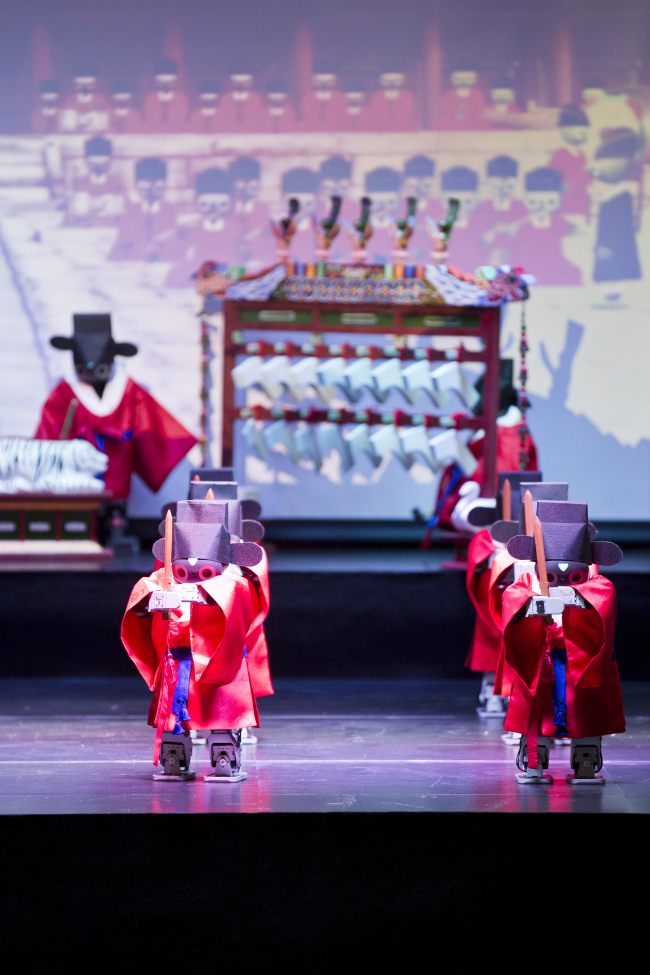Move over galleries, museums and theaters.
Royal palaces are the new face of Seoul’s vibrant art and culture scene ― at least for nine days starting on Sept. 20.
The first-ever Royal Culture Festival brings a plethora of performances, art exhibitions and cultural programs to four majestic royal palaces of Seoul, blending history, modern art and futuristic technology.
Cute robots reenact royal ancestral rites. The kings’ royal procession plays in a three-dimensional documentary film screened in a courtyard. The faade of the city’s signature Gwanghwamun Gate becomes the canvas for a contemporary media artist, illuminated at night with various colors and lights.
 |
Robots perform a royal ancestral rite. (Korea Cultural Heritage Foundation) |
These are just some of the numerous events that will take place day and night at the festival’s seven venues ― the four palaces (Gyeongbokgung, Deoksugung, Changgyeonggung and Changdeokgung), Jongmyo Shrine, Seoul City Wall and Gwanghwamun Plaza.
“The festival aims to re-present Joseon Dynasty’s royal palaces to modern-day Koreans and international tourists, by combining its tangible and intangible cultural heritage with today’s advanced technology and contemporary art,” explains Choi Yeong-ho, a director at the state-run Cultural Heritage Administration, one of the festival’s two organizers.
 |
Gwanghwamun Gate will be illuminated by colorful lights during the Royal Culture Festival. (Korea Cultural Heritage Foundation) |
It’s a pilot project, but the government hopes to turn it into an annual festival, he added.
Each of the four palaces boasts programs under distinctive themes. Gyeongbokgung focuses on rituals, offerings, and among other things, a series of performances by holders of state-designated intangible cultural heritage, while Changdeokgung highlights its scenic view and natural environment.
At Changgyeonggung, nightly programs, including concerts and site-specific lighting art exhibitions, stand out, as the place is known for its atmospheric beauty at night.
The theme for Deoksugung is the royal banquet and “pungryu,” offering a glimpse into how the ancestors appreciated art, nature and life. Pungryu is the Korean word for spending leisure tastefully.
At Jongmyo, a Confucian shrine for Joseon kings and queens, a nightly performance of jongmyo jeryeak, the royal ancestral ritual music designated by the UNESCO as Masterpieces of the Oral and Intangible Heritage of Humanity, will take place. It is the first time that the shrine will open its gate to visitors at night and for the first time that the ritual is performed at night.
Because there are too many events taking place at multiple venues at the same time and some programs require online reservation, the festival’s program director Kim Hyung-sung recommends visitors plan ahead before actually heading out.
“For foreign visitors, my recommendation is the Gyeongbokgung and Gwanghwamun area,” he said. Look around and enjoy various events at Gyeongbokgung during the daytime, enjoy the traditional performances at 7 p.m. in its front yard and then the Gwanghwamun Gate media art show at 8 p.m., he said.
On the eve of the festival, on Sept. 19, a special show combining traditional music, dance and other performances will be held at Gwanghwamun Plaza, starting at 8 p.m.
An information center will be set up at the front yard of Gyeongbokgung during the festival to provide help and information for visitors. English-language leaflets are available there. For more information, visit www.royalculturefestival.org.
By Lee Sun-young (
milaya@heraldcorp.com)









